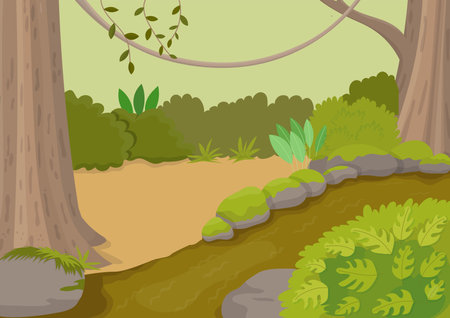Introduction to Native Plant Border Gardens
Native plant border gardens are growing in popularity among American homeowners, and for good reason. These types of gardens are designed using plants that naturally occur in a specific region, making them well-suited to the local climate, soil, and wildlife. A border garden typically lines the edge of a yard, path, or fence, creating a beautiful transition space that also serves an ecological purpose.
Unlike traditional ornamental borders that may rely on exotic or high-maintenance species, native plant borders offer sustainability and beauty with less effort. Because native plants have evolved in the local environment, they require less water, fewer chemical inputs, and minimal maintenance once established. They also support pollinators like bees and butterflies, provide shelter for birds, and promote biodiversity right in your backyard.
Why Choose Native Plants?
There are many advantages to planting native species in your garden border. Heres a quick comparison of native vs. non-native plants:
| Feature | Native Plants | Non-Native Plants |
|---|---|---|
| Water Needs | Low (once established) | Often high |
| Pest Resistance | Generally high | Varies; may need pesticides |
| Wildlife Support | Excellent (pollinators & birds) | Limited to none |
| Maintenance | Minimal | Can be labor-intensive |
The Rising Popularity of Native Borders
Across the U.S., gardeners are rethinking their landscapes by incorporating more native plants into functional designs like border gardens. This shift is driven by increasing awareness of environmental issues such as habitat loss, water shortages, and climate change. In addition to being environmentally friendly, native borders can be just as visually appealing as traditional gardens — full of color, texture, and seasonal interest.
If youre looking for a way to beautify your property while supporting local ecosystems, a native plant border garden is a smart and rewarding choice.
2. Choosing the Right Native Plants for Your Region
Picking the right native plants is the key to building a healthy and beautiful border garden that thrives year after year. To do this successfully, you’ll need to consider your USDA hardiness zone, your region’s climate, and the type of soil in your yard. Native plants are adapted to their local environments, so they generally require less water, fewer chemicals, and minimal maintenance once established.
Understanding Your USDA Hardiness Zone
The USDA Plant Hardiness Zone Map divides North America into 13 zones based on average annual minimum winter temperatures. Knowing your zone helps ensure the plants you choose can survive the coldest months in your area. You can find your zone by entering your ZIP code on the USDA website.
Consider Local Climate and Soil Conditions
Besides temperature, think about rainfall, humidity, sunlight exposure, and soil type (like clay, loam, or sandy). For example, desert regions need drought-tolerant natives, while coastal areas benefit from salt-tolerant species. Check with local extension offices or native plant societies for detailed info about your area’s conditions.
Regional Native Plant Examples
Here’s a quick guide to native plants that work well as borders in different parts of the U.S. Choose a mix of heights, bloom times, and textures to create visual interest throughout the seasons.
| Region | Recommended Native Border Plants | USDA Zones |
|---|---|---|
| Northeast (e.g., NY, MA) | New England Aster, Eastern Bluestar, Joe-Pye Weed | 4–7 |
| Southeast (e.g., GA, FL) | Coreopsis, Black-Eyed Susan, Beautyberry | 7–9 |
| Midwest (e.g., IL, OH) | Purple Coneflower, Prairie Dropseed, Wild Bergamot | 4–6 |
| Southwest (e.g., AZ, NM) | Desert Marigold, Penstemon, Apache Plume | 6–10 |
| Pacific Northwest (e.g., WA, OR) | Oregon Grape, Red-Flowering Currant, Sword Fern | 6–8 |
| California Coast | California Poppy, Ceanothus, Yarrow | 8–10 |
| Mountain West (e.g., CO, UT) | Rocky Mountain Columbine, Blanketflower, Blue Grama Grass | 3–7 |
Tips for Selecting Plants Locally
- Visit a native plant nursery: Staff can help you choose plants suited to your specific site.
- Avoid cultivars when possible: True native species offer better support for pollinators and wildlife.
- Diversify: Mix grasses, perennials, and shrubs for structure and resilience.
- Mimic natural groupings: Cluster similar species together to reflect how they grow in the wild.
Selecting region-appropriate native plants not only boosts your garden’s success but also supports local ecosystems by attracting birds, bees, butterflies, and beneficial insects.

3. Design Principles for a Functional and Beautiful Border
Creating a native plant border garden that’s both practical and visually appealing starts with understanding a few basic design principles. By carefully planning your layout, choosing the right color combinations, layering plant heights, and using texture and seasonal interest to your advantage, you can build a border that looks great year-round and supports local ecosystems.
Garden Layout Tips
Start by defining the shape and size of your border. Whether its curved or straight, consider how it complements your existing landscape. Place taller plants in the back (or center if it’s an island bed) and shorter ones in the front. Think about how youll access the plants for maintenance—leave space for walking paths or stepping stones if necessary.
Common Native Plant Border Layouts
| Layout Type | Description | Best For |
|---|---|---|
| Straight Border | A linear edge along fences or property lines. | Formal gardens, privacy screens |
| Curved Border | A flowing line with gentle curves for a natural look. | Cottage-style gardens, soft transitions |
| Island Bed | A standalone bed surrounded by lawn or paths. | Larger yards, focal points |
Using Color Schemes Effectively
Select native plants that bloom in complementary or analogous colors to create harmony or contrast. For example, pairing purple coneflowers with yellow goldenrods creates a vibrant pop of color. Stick to a limited palette to avoid visual clutter, especially in smaller borders.
Simple Color Scheme Ideas Using Native Plants
| Color Theme | Main Colors | Example Native Plants |
|---|---|---|
| Warm & Sunny | Yellow, orange, red | Black-eyed Susan, Butterfly Weed, Cardinal Flower |
| Cool & Calm | Purple, blue, white | Purple Coneflower, Blue Wild Indigo, White Wood Aster |
| Naturally Neutral | Green, beige, soft pinks | Sedges, Prairie Dropseed, Wild Geranium |
Layering Heights for Depth and Interest
A well-layered border has depth and structure. Use low-growing groundcovers at the front edge, medium-height perennials in the middle layer, and tall grasses or flowering plants at the back. This not only looks good but helps support pollinators at all levels of the garden.
Sample Height Layering with Native Species
| Layer Position | Plant Height Range | Example Native Plants |
|---|---|---|
| Front (Edge) | < 12 inches | Pussytoes, Creeping Phlox, Wild Strawberry |
| Middle (Fillers) | 12–36 inches | Bluestar, Purple Coneflower, Bee Balm |
| Back (Structure) | > 36 inches | Culver’s Root, Switchgrass, Joe-Pye Weed |
Create Texture and Seasonal Variety
Diversity in leaf shapes and flower forms adds texture to your border. Combine fine-textured plants like Little Bluestem with bold foliage such as Wild Senna. To keep your garden interesting year-round, mix species that bloom at different times—from spring ephemerals to fall asters—and include grasses or seed heads that look attractive through winter.
A Few Texture Pairings to Try:
- Smooth + Spiky: Pair smooth-leaved Wild Columbine with spiky Blazing Star.
- Dense + Airy: Mix dense-growing Yarrow with airy sprays of Prairie Dropseed.
- Tall + Low: Combine towering Cup Plant with creeping Wild Ginger at its base.
A thoughtfully designed native plant border garden not only enhances curb appeal but also provides vital habitat for birds, bees, and butterflies. With these simple design principles—layout planning, color coordination, layered heights, and seasonal interest—you’ll be on your way to creating a thriving garden that’s beautiful every month of the year.
4. Sample Native Plant Border Garden Plans
Creating a native plant border garden can be both beautiful and eco-friendly. Depending on your region and gardening goals, you can choose plants that support local wildlife, require minimal water, or offer year-round interest with little maintenance. Below are a few curated sample plans tailored to different needs and U.S. regions.
Pollinator-Friendly Border Garden (Eastern U.S.)
This plan attracts bees, butterflies, and hummingbirds while providing color throughout the seasons.
| Plant Name | Bloom Time | Height | Sun Requirements |
|---|---|---|---|
| Bee Balm (Monarda didyma) | Summer | 3–4 ft | Full Sun to Part Shade |
| Purple Coneflower (Echinacea purpurea) | Summer to Fall | 2–4 ft | Full Sun |
| Goldenrod (Solidago spp.) | Late Summer to Fall | 2–5 ft | Full Sun |
| Milkweed (Asclepias tuberosa) | Summer | 1–3 ft | Full Sun |
| Lupine (Lupinus perennis) | Spring to Early Summer | 1–2 ft | Full Sun to Part Shade |
Drought-Resistant Border Garden (Southwest U.S.)
This design focuses on native plants that thrive in dry conditions and add texture and color with minimal watering.
| Plant Name | Bloom Time | Height | Sun Requirements |
|---|---|---|---|
| Purple Sage (Salvia dorrii) | Spring to Summer | 2–4 ft | Full Sun |
| Brittlebush (Encelia farinosa) | Spring to Early Summer | 2–5 ft | Full Sun |
| Pineleaf Penstemon (Penstemon pinifolius) | LATE Spring to Summer | 1–2 ft | Full Sun |
| Cactus Barrel (Ferocactus wislizeni) | Sporadic Blooms in Summer | 1–3 ft wide/tall | Full Sun |
| Mojave Aster (Xylorhiza tortifolia) | LATE Winter to Spring | 1–2 ft | Full Sun |
No-Fuss Low-Maintenance Border (Midwest U.S.)
This layout is perfect for gardeners looking for easy-care native plants that look great with minimal upkeep.
| Plant Name | Bloom Time | Height | Sun Requirements | |
|---|---|---|---|---|
| Smooth Aster (Symphyotrichum laeve) | LATE Summer to Fall | 2–4 ft | Full Sun to Part Shade | |
| Season | Watering Tips |
|---|---|
| Spring (Year 1) | Water 1–2 times per week until roots are established. |
| Summer (Year 1) | Deep water early in the morning once or twice a week. |
| After Year 1 | Water only during extended dry periods (2+ weeks without rain). |
Smart Weeding Strategies
Weeds can compete with native plants for nutrients and water. Regular weeding—especially in the first year—is key. Use mulch to suppress weeds naturally and retain moisture.
Tips:
- Hand-pull weeds after rain when soil is soft.
- Avoid disturbing the soil too much, as it can bring new weed seeds to the surface.
- Add 2–3 inches of organic mulch annually in spring or fall.
Pruning and Deadheading
Natives don’t need heavy pruning, but light trimming helps keep your border looking neat and encourages healthy growth. Some plants benefit from deadheading (removing spent blooms) to promote more flowers or tidy seed heads.
What to Prune and When:
| Plant Type | When to Prune | Why It Helps |
|---|---|---|
| Perrenial wildflowers (e.g., Black-eyed Susan) | Late fall or early spring | Tidy up appearance; allow reseeding if left uncut. |
| Shrubs (e.g., Serviceberry) | Late winter or early spring before bud break | P romotes strong structure and flowering. |
| Late winter before new growth emerges | Makes room for fresh shoots; remove dead blades. |
Pest and Disease Monitoring
A well-balanced native plant garden usually resists most pests and diseases. However, its still good practice to inspect your plants regularly.
- If you notice chewed leaves or spots, identify the issue before taking action—many native insects are harmless or even beneficial!
- Avoid chemical treatments; instead, encourage birds and beneficial bugs by planting a variety of species and leaving some natural debris like leaf litter.
Tuning into Nature’s Cycles
The beauty of native gardening lies in working with—not against—the natural rhythms of your local environment. Observe how your garden changes through the seasons, note which plants thrive where, and adjust your care as needed. With a little patience and attention, your border garden will become more self-sustaining each year.
The goal isnt perfection—its creating a living space that supports local wildlife, reflects the beauty of your region, and requires less work over time. Let nature be your guide!


